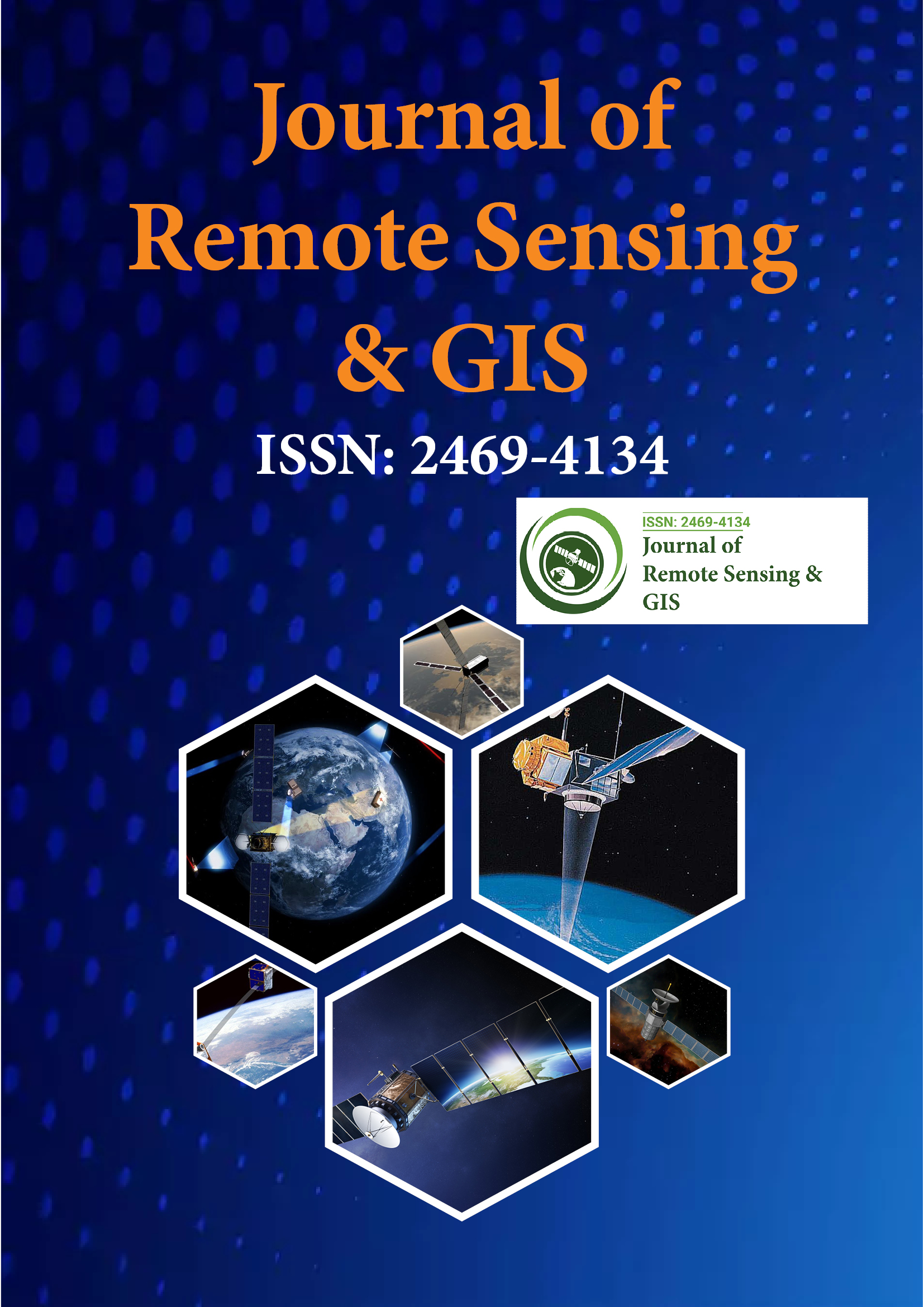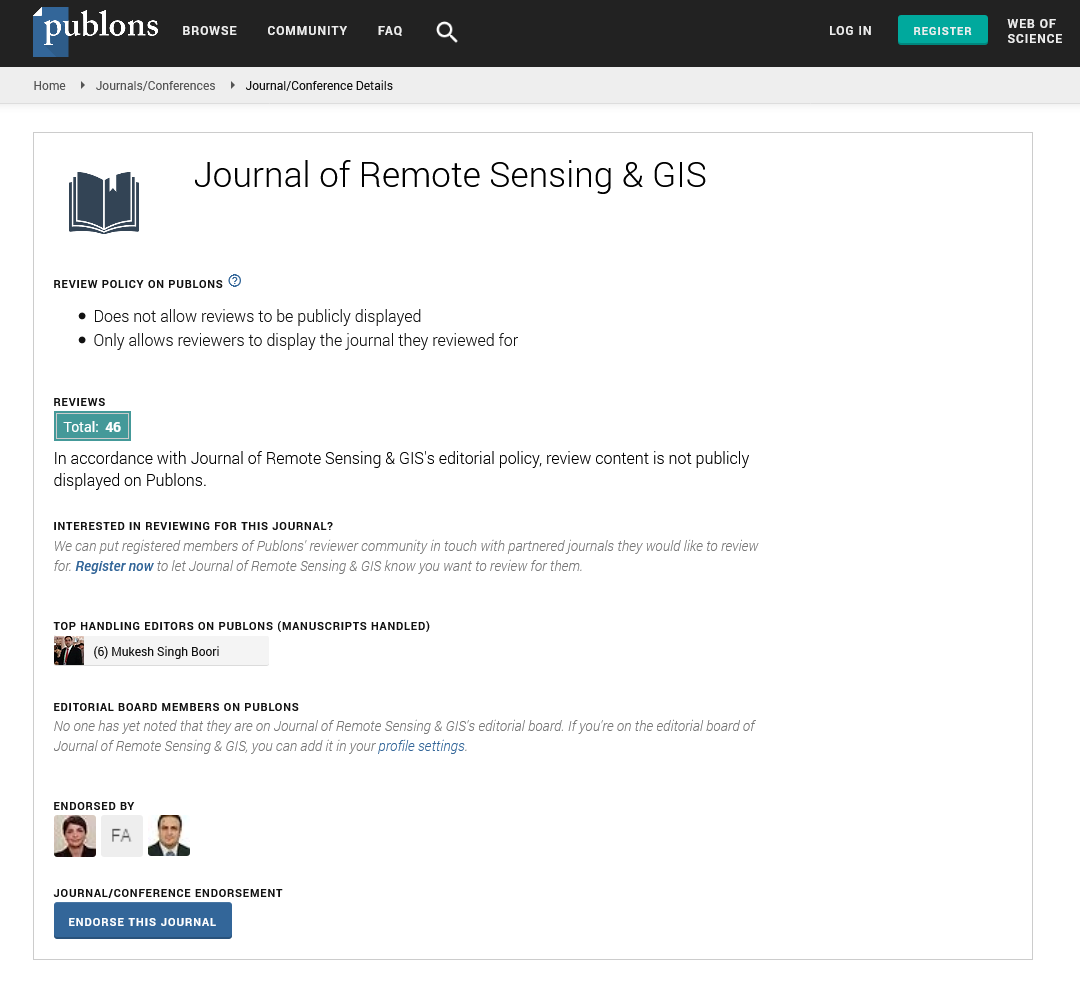Indexed In
- Open J Gate
- RefSeek
- Hamdard University
- EBSCO A-Z
- OCLC- WorldCat
- Publons
- International Scientific Indexing
- Euro Pub
- Google Scholar
Useful Links
Share This Page
Journal Flyer

Open Access Journals
- Agri and Aquaculture
- Biochemistry
- Bioinformatics & Systems Biology
- Business & Management
- Chemistry
- Clinical Sciences
- Engineering
- Food & Nutrition
- General Science
- Genetics & Molecular Biology
- Immunology & Microbiology
- Medical Sciences
- Neuroscience & Psychology
- Nursing & Health Care
- Pharmaceutical Sciences
Commentary - (2025) Volume 14, Issue 2
Integration of GIS and Remote Sensing in Disaster Risk Reduction
Melian Chen*Received: 06-Jun-2025, Manuscript No. JGRS-25-29355; Editor assigned: 09-Jun-2025, Pre QC No. JGRS-25-29355 (PQ); Reviewed: 23-Jun-2025, QC No. JGRS-25-29355; Revised: 30-Jun-2025, Manuscript No. JGRS-25-29355 (R); Published: 07-Jul-2025, DOI: 10.35248/2469-4134.24.14.382
Description
Disaster risk reduction involves the systematic approach to identifying, assessing and minimizing the impact of natural and man-made hazards on human life, infrastructure and the environment. As disasters become more frequent and severe due to climate variability, urban expansion and environmental degradation, the need for proactive and informed planning has grown. The integration of Geographic Information Systems (GIS) and remote sensing offers a powerful suite of tools for disaster preparedness, response and recovery.
Remote sensing provides synoptic and timely information about the Earth's surface, atmosphere and hydrological conditions before, during and after disasters. Satellites equipped with optical, radar and thermal sensors collect data on land use, vegetation cover, soil moisture, temperature, precipitation and elevation. These parameters are essential for monitoring hazards such as floods, landslides, earthquakes, droughts, wildfires and cyclones. Remote sensing enables wide-area surveillance and helps detect changes that may signal impending risks.
GIS complements remote sensing by allowing the integration, analysis and visualization of spatial and non-spatial data. Layers such as population distribution, infrastructure networks, health facilities, topography and historical hazard data can be overlaid to assess vulnerability and exposure. GIS facilitates modeling of hazard scenarios and supports the design of early warning systems, evacuation routes and resource allocation strategies.
In flood risk assessment, remote sensing is used to monitor rainfall, river discharge, soil saturation and land cover changes that influence runoff and inundation. Radar satellites such as Sentinel-1 provide all-weather and day-night observations, allowing accurate mapping of flood extent. When combined with digital elevation models in GIS, flood depth and flow direction can be modeled to identify high-risk zones. This information supports floodplain zoning, dam management and real-time alerts.
Earthquake-related damage can be assessed using pre- and post-event satellite imagery. High-resolution optical data helps identify building collapse, surface rupture and landslides triggered by seismic activity. In areas lacking ground-based monitoring, remote sensing provides a first overview of the damage footprint. GIS is used to overlay this information with population and infrastructure data to prioritize search and rescue operations and guide relief distribution.
In landslide-prone regions, remote sensing identifies terrain slope, vegetation cover and soil moisture factors that influence slope stability. Satellite images can detect land deformation and surface changes that precede slope failure. GIS-based susceptibility models combine these factors with rainfall intensity and land use data to delineate areas at high risk. These models inform land-use planning, infrastructure development and community awareness programs.
Wildfires are another hazard where GIS and remote sensing play a critical role. Satellite data on vegetation condition, temperature anomalies and smoke plumes enables detection of active fires and assessment of burned area. Remote sensing platforms like MODIS and VIIRS offer near real-time monitoring, while Landsat and Sentinel-2 provide detailed post-fire analysis. GIS integrates this information with land ownership, ecological zones and emergency services data to coordinate firefighting and recovery efforts.
In drought monitoring, remote sensing provides information on rainfall deficits, vegetation stress, soil moisture and surface water availability. Indices such as the Normalized Difference Vegetation Index (NDVI) and the Vegetation Health Index (VHI) help track agricultural drought conditions. GIS is used to visualize trends, assess the spatial extent of drought and estimate impacts on crop yield and food security. This supports early action by agricultural agencies and humanitarian organizations.
Cyclone and storm surge risk assessments use remote sensing for tracking storm movement, cloud cover, sea surface temperature and coastal inundation. GIS tools simulate wind fields, wave heights and storm surge extent based on satellite data and meteorological models. This supports the planning of shelter locations, evacuation routes and emergency logistics. After the event, damage assessment maps are created using post-cyclone imagery to support insurance claims and recovery planning.
Beyond hazard monitoring, GIS and remote sensing contribute to long-term resilience building. They support vulnerability mapping by identifying settlements in high-risk zones, communities with limited access to health services, or infrastructure in fragile ecosystems. Participatory GIS approaches engage local communities in mapping their own risks and resources, promoting inclusive and context-specific solutions. Historical disaster databases maintained in GIS platforms allow trend analysis and risk modeling to inform national disaster risk reduction strategies.
Advances in cloud computing and mobile technologies have expanded access to these tools. Platforms like Google Earth Engine, Copernicus Open Access Hub and NASA’s earth data provide free satellite imagery and processing capabilities. GIS software now includes modules for disaster risk management and mobile apps allow field teams to collect georeferenced data in real time. These developments have democratized the use of geospatial tools and enhanced coordination among agencies, NGOs and communities.
Challenges remain in the integration of GIS and remote sensing, including data resolution, interoperability, internet access and capacity building. Differences in data formats, timeframes and accuracy can affect analysis. Training in data interpretation, modeling and scenario planning is essential to ensure that decision-makers can effectively use geospatial outputs. Continued investment in infrastructure and partnerships is necessary to maintain and expand these capabilities.
In conclusion, the integration of GIS and remote sensing has significantly improved the ability to anticipate, prepare for and respond to disasters. By combining observational data with analytical tools, these technologies provide a spatial understanding of hazards, vulnerabilities and capacities. They support risk-informed decision-making at all stages of disaster management, from early warning to recovery. As global risks evolve, the continued use and development of geospatial approaches will be vital in building more resilient communities and sustainable systems.
Citation: Chen M (2025). Integration of GIS and Remote Sensing in Disaster Risk Reduction. J Remote Sens GIS.14:382.
Copyright: © 2025 Chen M. This is an open-access article distributed under the terms of the Creative Commons Attribution License, which permits unrestricted use, distribution and reproduction in any medium, provided the original author and source are credited.

